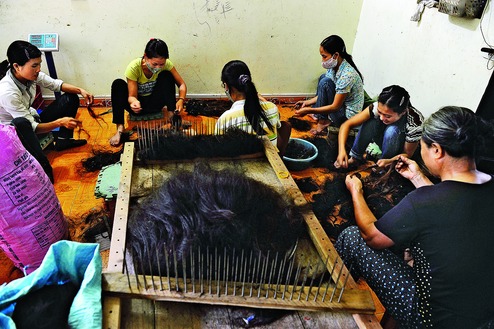

It all begins when we see the sweeper at a local beauty parlour stuffing a blue plastic bag with hair. What is it for? Wigs, he replies. How much does it sell for? As much as Rs 5,000 for a kilo, he answers absent-mindedly. "But not all hair can be sold; only those bits measuring a minimum of six inches. There are other parameters as well," he continues. And who would buy all this? This time, he visibly stiffens. "I don't know" are the words that come out of his mouth, but his expression says something else. After much prodding, all that he reveals is this - there are some men who do rounds of the neighbourhood parlours once or twice a week, they are the ones who buy the wasted hair. He has no idea who they are or who they work for, but one thing he can say for sure - women's hair is used to weave wigs and men's hair goes towards making headpieces for mannequins.
Some amount of prowling in the virtual space throws up hundreds of small and medium wig retailers. Their product descriptions run thus - natural hair wigs, human hair wigs, gents wigs, wavy hair wigs, hand weft hair, polyfuse wig, single drawn remy human hair... Many of these manufacturers and suppliers are based in Bengal. We pick a number and call.
Dipesh Chatterjee of Konnagar is one such retailer. His online descriptor reads: international wig manufacturer and supplier. At first he is eager to engage. How many wigs do we need? What kind? He stocks only the premium variety. The cheapest comes at Rs 20,000. A really special piece can cost up to Rs 1.5 lakh. Both kinds last a maximum of six months to a year, depending on the nature of use. The wigs are made in China, Korea, but the hair is shuddh desi, he jokes even. His wigs sell domestically and also abroad - Argentina, Australia, New Zealand, Dubai. But once it is our turn to ask questions, he, too, starts to play dodge. After several rescheduled appointments, Chatterjee stops taking calls.
We learn from a beautician about a shop in New Market that is into the business of exporting hair and importing wigs. We don't have names but there is a shop selling wigs. We point to a long, chestnut-coloured one hanging from a hook. "That's synthetic," says the shopkeeper. "There are nylon ones too," he adds. When we ask for wigs made of human hair, he looks at us critically and then replies that that can be arranged. "But those are expensive," he warns. "We can supply customised products. We also do patches. We will measure your head and weave it accordingly. Just give us a fortnight."
The fire test is apparently the surest test of authenticity. If you put a match to a synthetic wig, it will go up in flames at once, whereas one made from real hair will char slowly. When we say we want to visit the manufacturing facility to ensure product quality and working conditions, he panics. Thrusting a visiting card into our hands, he is gone.
A customs official who does not wish to be named throws light on the series of silences, the entire hide and seek. He says, "No part of the human body can be imported or exported. That is what the law of the land stipulates. If people are trading in human hair internationally, it is illegal." He hints that a substantial supply of human hair comes from Bangladesh. And then he, too, refuses to say more.
From talking to others in the business we gather that among other things, clever packaging helps dealers get these contraband items past customs. "The scanners cannot detect the carefully sorted hair. And then, of course, there are reliable contacts," says one retailer who refuses to be identified. He also points out that part of the secrecy around wig manufacturing units has to do with keen competition.
Riya Chakraborty works for Hair Life India, a wholesale company of wigs made only out of human hair. She does not seem to have any qualms discussing her company's business. "Everything is open and legal," she says. According to her, the hair used in wigs is sourced from temples, parlours - some people sell it for money - and discarded hair from small para salons. She talks about one of the services offered by Hair Life - fixing hair patches and wigs permanently to the scalp. These are, apparently, fixed with glue and one can comb, wash and sleep in these. Some people even get these faux hair highlighted or coloured.
Among her clients are celebrities such as ghazal singer Pankaj Udhas, those in service, cancer patients, natty college-goers. And while she is unwilling to let in on more, she does leave us with a thought - "If you thought that most of the takers are vain women, you couldn't be more wrong." Covert to the end, the hair trail.










